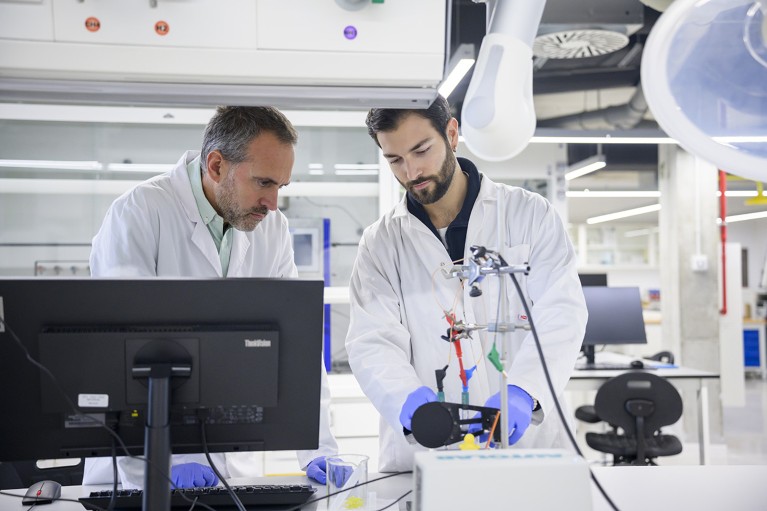
Lluís Soler Turu (left) at the Polytechnic University of Catalonia hydrogen laboratory in Spain.Credit: Paul Mac Manus/CCEM UPC
With record-breaking heatwaves, wildfires and floods, Spain is experiencing the impacts of climate change first-hand — underscoring the urgent need for a transition to cleaner, more-sustainable energy systems. Green-hydrogen power, produced from renewable-energy sources such as wind and solar, has emerged as a promising solution in the global shift away from fossil fuels, and Spain’s strategic location on the Iberian Peninsula makes it a strong contender to lead this transition.
Nature Spotlight: Spain
The region experiences the highest number of sunshine hours and some of the highest wind speeds in Europe, making it an ideal base for the renewable-energy production needed to generate hydrogen power. For these reasons, the nation’s leaders have set ambitious targets for renewable hydrogen deployment, aiming to use their network of green hydrogen valleys — several initiatives focused on producing, storing and transporting hydrogen — to reach an electrolyser capacity of 4 gigawatts by 2030.
Lluís Soler Turu, deputy director of the Specific Center for Hydrogen at the Polytechnic University of Catalonia (UPC) in Barcelona, Spain, thinks that this can be done. His work, which involves investigating the production and transformation of hydrogen as a sustainable-energy option, has given him insight into its future, and he describes the opportunities and challenges in the industry.
Why is hydrogen technology important for Spain?
There’s no doubt that climate change is already causing higher temperatures and extreme weather in this region: last year, Catalonia experienced its worst drought on record. The country’s leaders know that they must switch from fossil fuels to green technologies such as hydrogen power. The cost of climate-change impacts is mounting, but it’s still possible to change the trajectory.
Hydrogen power is made by splitting water into hydrogen and oxygen using electricity, a process called electrolysis. ‘Green’ hydrogen is produced from renewable sources, such as solar or wind power, without producing pollution or carbon emissions, and unlike solar or wind, it can be stored easily. It is a clean alternative to gas, coal and diesel, and is versatile: you can use it to generate electricity, as a raw material or even burn it to heat homes. But green hydrogen is an energy carrier, not a source — expanding hydrogen’s production will require more renewable-energy infrastructure, which will include building more solar panels and wind turbines on the Iberian Peninsula.
What work are you doing with the UPC Hydrogen Laboratory?
In 2021, my research group received funding to develop a ‘living laboratory’ — integrating research and practical, real-world innovations between academia and industry — for research into the production, storage and use of hydrogen. The hydrogen and electricity used in the lab for experiments such as fuel-cell testing is produced sustainably, on the roof of our building: we have our very own microgrid, consisting of 24 solar panels and 6 electrolysers, which allows us to produce 6 kilograms of hydrogen per day. We can also store up to 16 kg at any one time, which is enough to power our research all day, as well as the training activities and industry collaborations that we host on-site.
The lab also has a 3-square-metre environmental-testing chamber, in which we can tune the relative humidity and temperature to test things such as fuel cells. These are devices that convert hydrogen gas into electricity to power an electric motor, and they can be used for larger vehicles, such as a bus or a truck. The testing chamber is capable of mimicking extreme temperatures (40–80 °C), with a maximum power of 100 kilowatts, which means that the device will be safe and efficient in real-world conditions — even during a Finnish winter or a Moroccan summer.
One of our most exciting projects is with the Catalan government to turn one of the region’s airports, Lleida–Alguaire, into a self-sustaining hub for hydrogen production and research. The airport, which is located around 150 kilometres from Barcelona and serves around 40,000 passengers annually, has been open for 15 years, but it will soon start to produce its own green hydrogen, using 1,768 solar panels and a 100-kW electrolyser, with the aim of generating 5–6 tonnes of hydrogen annually (enough to power a car for up to 600,000 km), supporting local industries and sustainable aviation-fuel development.
What needs to happen for hydrogen to become widely used?
At the UPC, we produce green hydrogen through electrolysis using renewable electricity, which means that no carbon dioxide is released into the atmosphere. We also investigate catalysts for producing blue hydrogen from methane or bioalcohol steam, in which the CO2 is captured, not released — because the CO2 can be used in many ways in research. For this reason, I prefer the term defossilization rather than decarbonization when we talk about the green-energy transition.
Currently, most of the industrial sector uses grey hydrogen, which is produced from natural gas using steam-methane reforming, a process that releases CO2 into the atmosphere without capturing or storing it, and is therefore high in CO2 emissions. The main barrier to moving away from this process is cost: green hydrogen is US$5–8 per kg to buy, compared with $1 for grey hydrogen. This is because of the efficiency of the electrolysers used to generate green hydrogen: currently only 70% of the energy input is converted, meaning that 30% of the electricity we introduce into the electrolyser gets lost.



